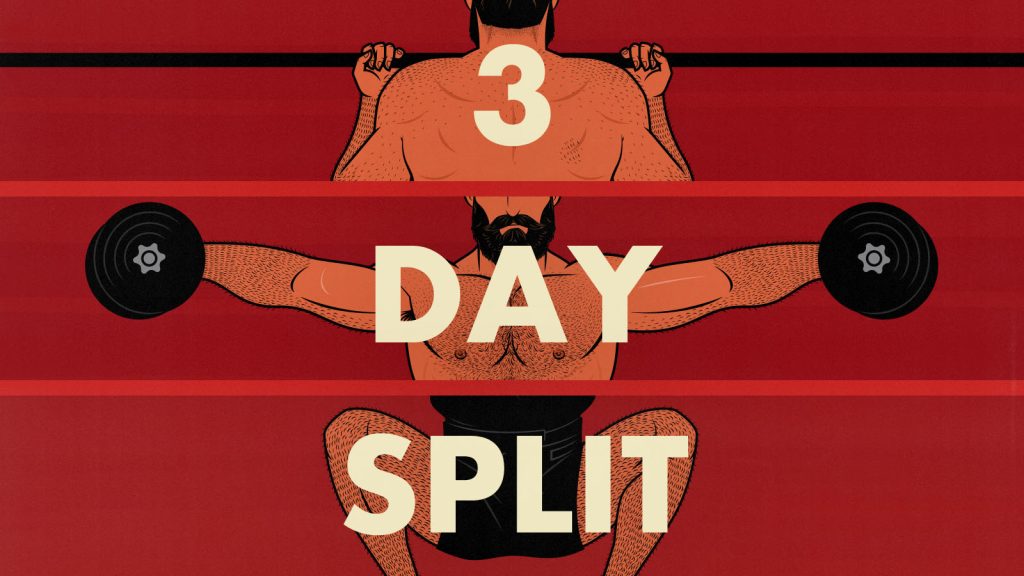
The 3-Day Workout Split (Full Workout Routine)
A 3-day workout split is enough to maximize your overall rate of muscle growth, especially if you’re still in your first couple of years of lifting. To maximize the growth of any one muscle, you need to train it at least twice per week. With three workouts per week, that’s easy.
Full-body workouts also allow for more synergy than any other workout routine. You can do the best exercises every workout. You can use supersets and giant sets, making your workouts more efficient. And you get to practice all the big movement patterns 3x per week. You also get 1–2 days of rest between each workout, making it easier to schedule cardio and giving your grip and postural muscles time to recover.
You could make a strong argument that 3-day routines are the best default for natural lifters. They’re almost certainly ideal for novices and early intermediates, and most bodybuilders from the pre-steroid era (such as Steve Reeves) used 3-day routines all through their careers, so there’s never a point where they stop being effective.
The catch is that as you get stronger, full-body workouts take longer. That’s why some advanced lifters switch over to 4-day, 5-day, or 6-day routines. Another option is to drop some of the big compound lifts, doing them 2x per week instead of 3x. Or you could switch over to a 3-day specialization routine (which I’ll cover below).
I’ve gained 70 pounds, and around 60 of those pounds came from 3-day workout programs. At first, I was doing full-body workouts. More recently, I’ve been running specialization programs (like this arm program).
Why a 3-Day Split?
A 3-day workout routine gives you plenty of time to stimulate muscle growth, but you have to be efficient. When you’re doing a full-body split, the first 50–75% of your workouts ought to be focused on the big compound exercises:
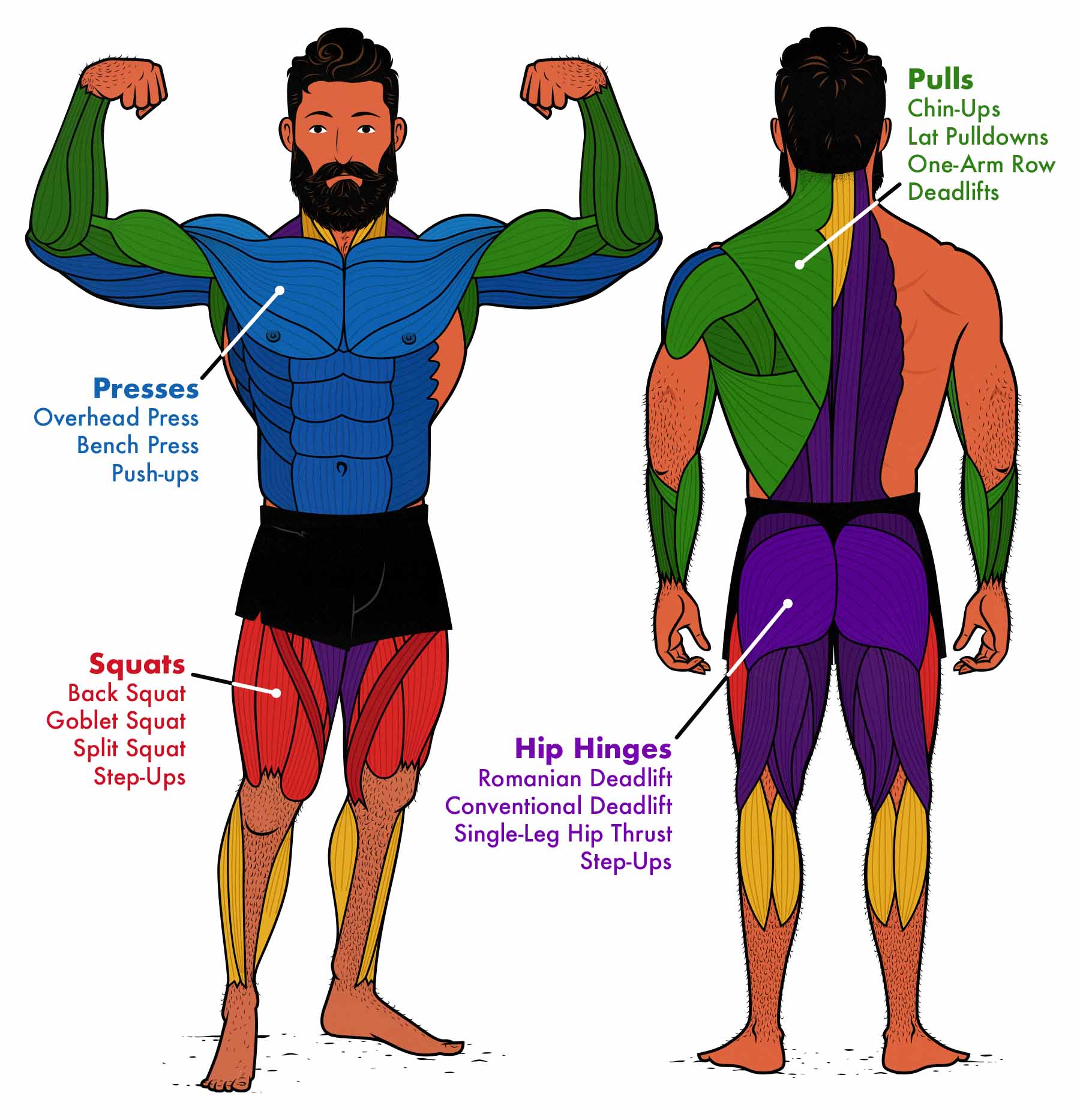
- Presses (push-ups, bench presses, and overhead presses) for your chest, shoulders, triceps, and serratus anterior (underneath your armpits).
- Pulls (chin-ups, pulldowns, and rows) for your upper back, lats, biceps, and forearms.
- Hip hinges (deadlifts and step-ups) for your hips, hamstrings, and postural muscles.
- Squats for your quads, hips, and postural muscles.
You don’t need to be quite as efficient as with a two-day routine. You could do fewer exercises per workout, you could pour some extra sweat into your favourite isolation exercises, speeding up muscle growth in your arms, shoulders, chest, or back
You can also use a mix of bilateral (both sides at once) and unilateral (one side at a time) exercises:
- Bilateral exercises like squats, deadlifts, push-ups, and chin-ups are stable and efficient, making them amazing for overall muscle and strength gains.
- Unilateral exercises like one-arm overhead presses, one-arm rows, split squats, and step-ups force you to stabilize your core, and they do a better job of working some of the muscles in your groin and shoulder girdle. Training one side at a time also allows you to pour more effort into that one side of your body, which might improve performance (study). Some unilateral exercises target different muscles, too, like how split squats work your back leg’s rectus femoris—a quad muscle that isn’t trained very well with regular squats.
The downside to three-day workout routines is that you don’t have that much freedom to use different training splits. You could alternate between upper and lower-body workouts (workouts here). That can work quite well, but most people prefer to do a 3-day full-body split or a specialization routine.
3-Day Beginner Routine
We’ve got another article walking you through a 3-day, full-body muscle-building routine for beginners. It comes with free workout sheets you can fill in.
The workout sheets are programmed into Google Sheets, which are totally free, with no monthly fee. You can use them on desktop or mobile.
You can do the workout routine in your living room with adjustable dumbbells, in a barbell home gym, or with a gym membership. All of the exercises are linked to our tutorial videos.
3-Day Intermediate Workout Routine
Ideally, you’d have 1-2 days of rest between each workout, but it’s okay to do them one after another. Your performance will suffer if you haven’t recovered yet, but you’ll stimulate a similar amount of muscle growth, and you’ll gain a similar amount of strength in the long run.
- Monday: Workout 1
- Tuesday: Rest
- Wednesday: Workout 2
- Thursday: Rest
- Friday: Workout 3
- Saturday: Rest
- Sunday: Rest
You’ll probably be training sore, especially at first. It’s common for muscle soreness to peak about two days after working out, especially when you first start lifting. That’s perfectly fine. It will keep your muscles growing steadily all week long.
Most of the soreness will fade while warming up. If the soreness is extreme, you’re training harder than you can properly recover from, so do fewer sets or stop further away from failure.
Start with 2-3 sets per exercise and work your way up from there. That will keep your soreness manageable. Then, as your muscles grow tougher, you can gradually add more sets. I like to add 1 set to a couple of exercises every time I repeat a workout. Stop adding sets whenever you like.
These are full-body workouts, but they use different overlapping exercises. We want to stimulate most of the muscles in your body each workout, but we also want to get a nice variety of exercises to build a more balanced physique.
For example, one workout might have a bench press, and another might have push-ups. The bench press is easier to progressively overload. Push-ups do a better job of working your postural muscles and serratus anterior. It helps to do both.
We repeat the most important exercises 2–3 times per week. You’ll be doing lots of push-ups, squats, Romanian deadlifts, pulldowns, and rows. Some are bilateral, others are unilateral.
Full-Body Workout 1
We’ve organized these exercises so that you can do supersets. For example, you can do a set of back squats, rest for a minute, drop down for a set of push-ups, rest for another minute, and then do your second set of squats. These supersets are optional, but full-body workouts can get long, and this will help.
All the links lead to tutorial videos of Marco teaching the exercises.
| Exercise | Sets | Reps |
|---|---|---|
| Back Squat | 3–5 sets | 6–10 reps |
| Push-Ups | 3–5 sets | AMRAP |
| Romanian Deadlifts | 2–3 sets | 8–12 reps |
| One-Arm Overhead Press | 2–4 sets | 8–12 reps/side |
| Lat Pulldowns | 2–3 sets | 8–12 reps |
| Farmer Carries | 2–3 sets | 40 steps |
This workout focuses on your chest, back, quads, and shoulders. Here are my favourite swaps:
- Back Squat: dumbbell goblet squat, front squat.
- Push-Ups: dips, dumbbell bench, or barbell bench.
- Romanian Deadlift: dumbbell Romanian deadlift or conventional deadlift.
- One-Arm Overhead Press: barbell overhead press or machine press.
- Lat Pulldown: chin-up, pull-up, or dumbbell pullover.
- Farmer carries: dumbbell or barbell shrugs.
Full-Body Workout 2
| Exercise | Sets | Reps |
|---|---|---|
| Chin-Up | 3–5 sets | AMRAP |
| Split Squat | 3–5 sets | 8–12 reps/side |
| Deadlift | 2–3 sets | 5–10 reps |
| Push-Ups | 2–3 sets | AMRAP |
| Dumbbell Curls | 2–3 sets | 8–15 reps |
| Triceps Extensions | 2–3 sets | 8–15 reps |
This workout focuses on your back, chest, hips, arms, shoulders, and postural muscles. Here are my favourite exercise swaps:
- Chin-Up: pull-up, lat pulldown, or dumbbell pullover.
- Split Squat: goblet squat, front squat, or leg press.
- Deadlift: sumo deadlift, dumbbell step up, or good morning.
- Push-Ups: raised push-ups, deficit push-ups, or dips.
- Dumbbell Curls: curl-bar curls, barbell curls, lying curls, or preacher curls.
- Triceps Extensions: overhead triceps extensions, skull crushers, or cable pushdowns.
Full-Body Workout 3
| Exercise | Sets | Reps |
|---|---|---|
| Bench Press | 3–5 sets | 6–12 reps |
| One-Arm Rows | 3–5 sets | 8–12 reps/side |
| Lat Pulldowns | 3–4 sets | 8–12 reps |
| Step-Ups | 3–4 sets | 8–12 reps/side |
| Lateral Raises | 2–4 sets | 10–15 reps |
| Reverse Crunches | 2–3 sets | AMRAP |
- Bench Press: dumbbell bench press or machine chest press.
- One-Arm Rows: bent-over barbell row, seated cable row, or t-bar row.
- Lat Pulldowns: pullovers, pull-ups, or chin-ups.
- Step-Ups: Romanian deadlifts or leg curls.
- Lateral raises: lying lateral raises or upright rows.
- Reverse Crunches: weighted crunches, planks, or leg raises.
3-Day Specialization Routine
The problem with full-body workouts is that they can be long and tiring. As you get stronger, you’ll be doing more warm-up sets and lifting heavier weights, making the workouts even longer and more tiring. If you’re in great cardiorespiratory shape, you’ll be able to keep up. But even then, you might want a break.
One way to make the workouts easier is to reduce the frequency of the big compound lifts. Instead of squatting, deadlifting, pulling, and pressing 3x per week, you could drop it down to 2x. That makes each workout quite a bit easier. That’s great when you’re maintaining or cutting or if you’re okay with slower progress… but it isn’t the fastest way to bench 225 pounds, get your arms to 16 inches, or build a glute shelf.
Specialization routines allow you to make faster progress in certain muscles. It shifts most of your muscles to bare maintenance, freeing up extra time, energy, and recovery resources to invest in just a few muscle groups. Specialization routines are usually easier than balanced routines and can yield faster progress in your target areas than training 5+ times per week.
A single full-body workout per week is enough to maintain your muscle size. That leaves two workouts per week to focus on the area(s) you’re most eager to grow. For example, you could train your arms (or butt/thighs, chest/back, bench press/deadlift, etc) on Monday and Friday, then train the rest of your body on Wednesday.
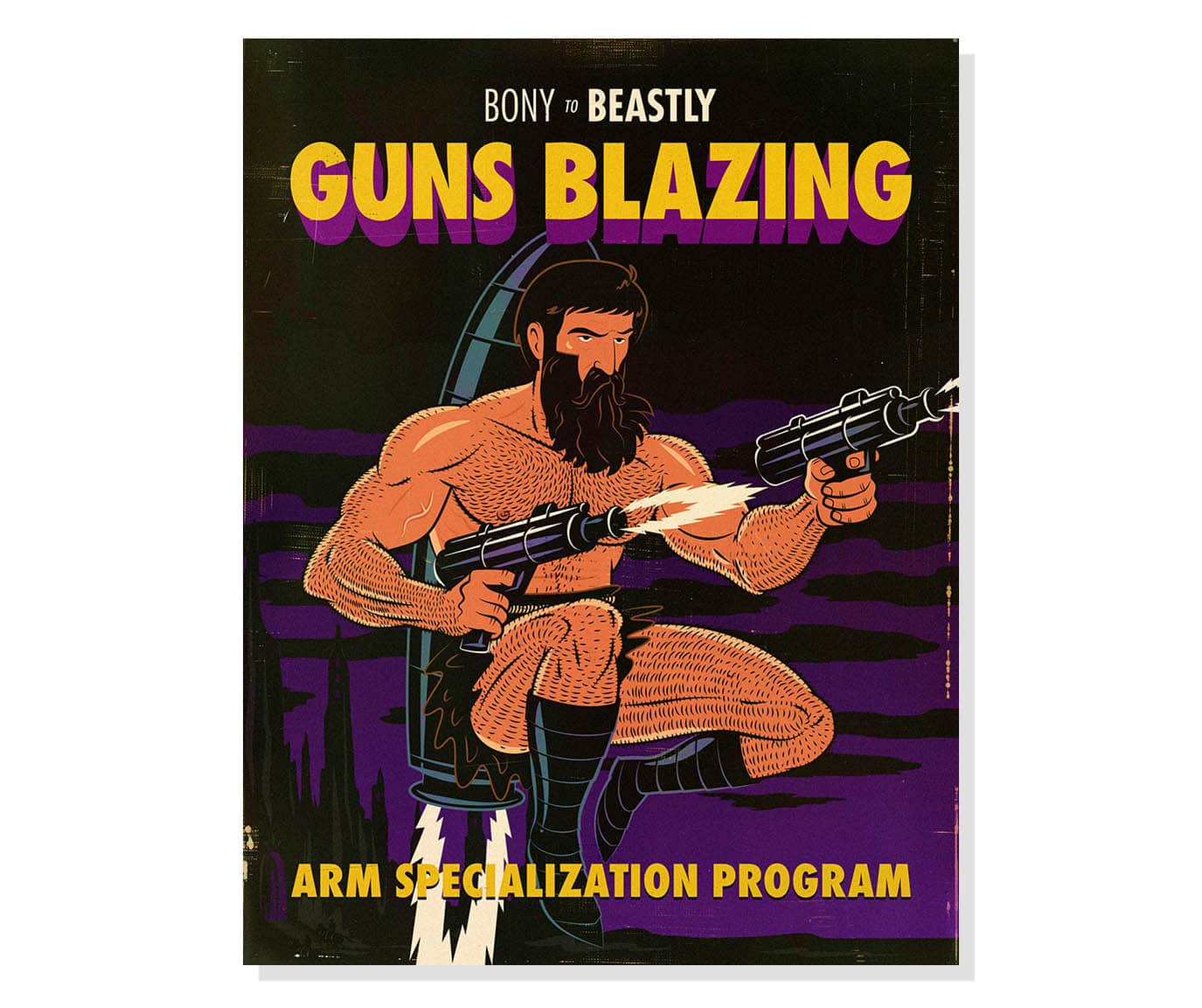
Here’s our brand new 3-day arm specialization routine and chest specialization program. We also have a men’s program with an emphasis on the upper body and a women’s program with an emphasis on the lower body.
Supersets
3-day splits usually have quite a few exercises in each workout, so it’s important to keep your pace up. One way to do that is to use short rest times, which we’ll talk about in a moment. The other way is to use supersets, where you alternate between different exercises, like this:
- Deadlifts, set 1. Rest a minute (or less).
- Push-ups, set 1. Rest a full minute.
- Deadlifts, set 2. Rest a minute (or less).
- Push-ups, set 2. Rest a full minute.
You need at least 2–3 minutes of rest between sets of deadlifts. With supersets, those muscles still get the rest they need, but you’re doing your push-ups while you wait. This makes your workout about 33% shorter. It also keeps your heart rate higher, which is great for your cardiorespiratory fitness.
The only downside to supersets is that they’re inconvenient. If you train in a crowded gym, it’s hard to hog the bench press and the squat rack. If you train at home, you might not have enough equipment to set up multiple big exercises. So, it’s better to combine exercises like deadlifts and push-ups, which don’t add any extra equipment. Squats and chin-ups also pair well.
If you can make it work, I highly recommend supersets. They aren’t mandatory, though. They won’t affect your muscle growth. More on supersets here.
Rest Times
Full-body workouts can run long, so it’s helpful to be strict with your rest times. We recommend 3 minutes of rest on the big compound exercises and 1–2 minutes on the smaller exercises. If you can’t time your rest times, pace around until your breathing is almost back to normal.
If short rest times make you nauseous or if you enjoy marathon workouts, you can extend the rest times. Extending the rest times won’t affect your muscle growth. More on the rest times here.
Reps in Reserve
You don’t need to take your sets all the way to failure, but you have to get close. You aren’t training very often, so you have plenty of time to recover. Better to push yourself harder.
I recommend getting within 2 reps of failure squats, deadlifts, and bench presses. You can push your other exercises within 1 rep of failure and take the last set all the way to failure (if it feels safe to do so). More on reps in reserve here.
Progressive Overload
Progressive overload is the idea that when you challenge your muscles, they grow bigger, stronger, and tougher. Thus, to continue challenging your growing muscles, you need to lift progressively heavier weights, do more reps, or find another way to make your workouts more challenging:
- Add a little bit of weight. Add 2.5 pounds to either side of the barbell. Go from the 20-pound dumbbell to the 25-pound dumbbell. Raise your feet up when doing push-ups.
- Fight to squeeze out more reps. If you got 10, 9, and 8 reps in your three sets, that’s 27 total reps. Try for 28+ reps next time.
There’s another side to it, too. If you’re able to lift more weight or get more reps than last week, then it shows you’ve gotten stronger. That’s a great sign of progress. If you aren’t making progress, you probably need to train harder, add more volume, get more sleep, or fix your diet.
How to Eat for Muscle Growth
You can use a 2-day workout routine to bulk, cut, recomp, or maintain. It’s a balanced routine that will stimulate muscle growth all through your body. To make the most of it, though, you need to eat in a way that supports muscle recovery and growth:
- Eat at least 0.7 grams of protein per pound of body weight per day. You only need about 0.4 g/lb/day for general health, but it helps to eat a little more when you’re being active and/or lifting weights. More here.
- Eat a balanced mix of carbs and fat. Low-carb diets can be good for losing fat. Moderate-to-high carb diets are often better for improving weight training performance, cardio performance, and muscle growth. I recommend eating a balance of both. Full research breakdown here.
- Eat nutritious foods. You probably have a good intuitive idea of which foods are healthy. Think of foods like fruits, veggies, lean meat, fatty fish, whole grains (including oats, corn, brown rice, quinoa, etc), beans, nuts, seeds, avocados, yogurt, cheese, olive oil, dark chocolate, coffee/tea, and plenty of spices. We have recipes here.
If you’re really trying to prioritize muscle growth, I wrote a full article on how to eat a bulking diet.
You don’t need to track your calories, especially if you’re maintaining or recomping. The simplest approach is to weigh yourself every week to see if your weight is moving in the right direction. If it isn’t, eat a little more or less. Keep adjusting until you’re getting the results you want.
If you want to track your calories and macros, we have a beginner’s guide to tracking. We also have a bulking calorie calculator, a cutting calorie calculator, a recomp calculator, and a maintenance calculator. If you want a calorie-tracking app, we recommend this one.
Alright, that’s it for now. If you want a full program and online coaching from Marco and me, check out our 3-day men’s program and 3-day women’s program. Good luck!




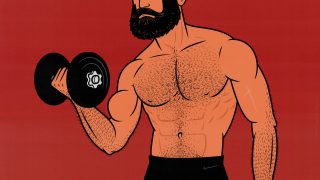
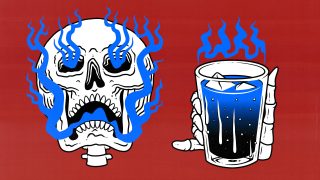
Hey Guys,
I’ve been using this free program with great success over the past 7 months. I always thought that I just couldn’t gain muscle or get bigger, but after going through your website, you convinced me to give it a try. Despite not being completely consistent with the workouts or the diet, I went from 160 pounds to 174 pounds at 5’11 and my body fat only went up from 12 to 14 percent. All this at 40 years old! I look better than ever and people notice it. Even 14 pounds have completely changed how I feel about myself and my body. And it turns out that I love lifting! I’m interested in the aesthetic side of things as well. I seem to be biased towards having a heavier lower body and slighter upper body. According to your aesthetics calculator, I’m already pretty much dialed in at ideal measurements for hips, thighs, and calves, and still have some growing I could do everywhere on my upper body. I like the full body workouts but am wondering how to adjust them to bias my future gains more towards upper body. Do you offer a plan for guys in this situation? I’ve already ripped open a pair of shorts squatting in the gym, I would love to do that to some sleeves! Thanks for the awesome content and fantastic articles. Your stories really inspired me.
Stephen, that’s awesome! Congratulations, man. 14 pounds is great.
I hear you about thinking it was impossible. I felt that way, too. I thought being skinny was my body type. I didn’t realize it was possible to make much of a change.
Have you seen our Health and Aesthetics Program? It’s got a heavy emphasis on the upper body, and most of the guys doing the program are about the same age as us. (I’m 37.) That’s the program I’m doing, too. And we’ll also teach you everything you need to know about nutrition, lifestyle, and tracking your progress. And we’ll guide you through all of it online. It comes with personal support.
If you specifically want to burst open your shirtsleeves, you might like Guns Blazing. That’s our arm specialization program. Although I suppose the theme is more about burning off your sleeves.
I think those are the two that would fit your goals the best.
I did your workout for over half a year, and I really liked it. One reason was, if you change the order a bit, you can actually do supersets of 2 or even 3 in the same area. For example, in workout one, I do the squats, pushups, and one-arm overhead press together (it’s difficult to superset 3 exercises, but it’s doable).
And I saw some very good results.
However, I then started doing my own routine,
Workout 1: Squat, Bench, Rows, barbell overhead press, Lat pulldowns, barbell curls, tricep pushdowns.
Workout 2: Pendlay Rows, Optional back exercise, Hip Thrust, Calf raises, lateral raises, tricep pushdowns.
Workout 3: Pushups, Dips, Deadlift, hip extensions, chinups, one-arm seated dumbbell curls
(at the end of every workout I do cable face pulls, and 2 times a week I do a a core workout, making sure in 2 weeks I’ve done anti-extension, anti-rotation, anti-lateral bending and anti-flexion).
Everything is done in 3 sets of 6-10 reps, with the exception of the bicep workouts (2 x 12-15), triceps (2-3 x 10-12), barbell back squats (3 x 5-8), and the deadlift (2 x 6-8). Once I can do 3 sets at the max rep range, then I up the weight.
I don’t know why, but I really, really am enjoying my own workout. Maybe it’s not complete. And of course it would benefit from having more unilateral exercises, but they take more time.
But I’m really loving it.